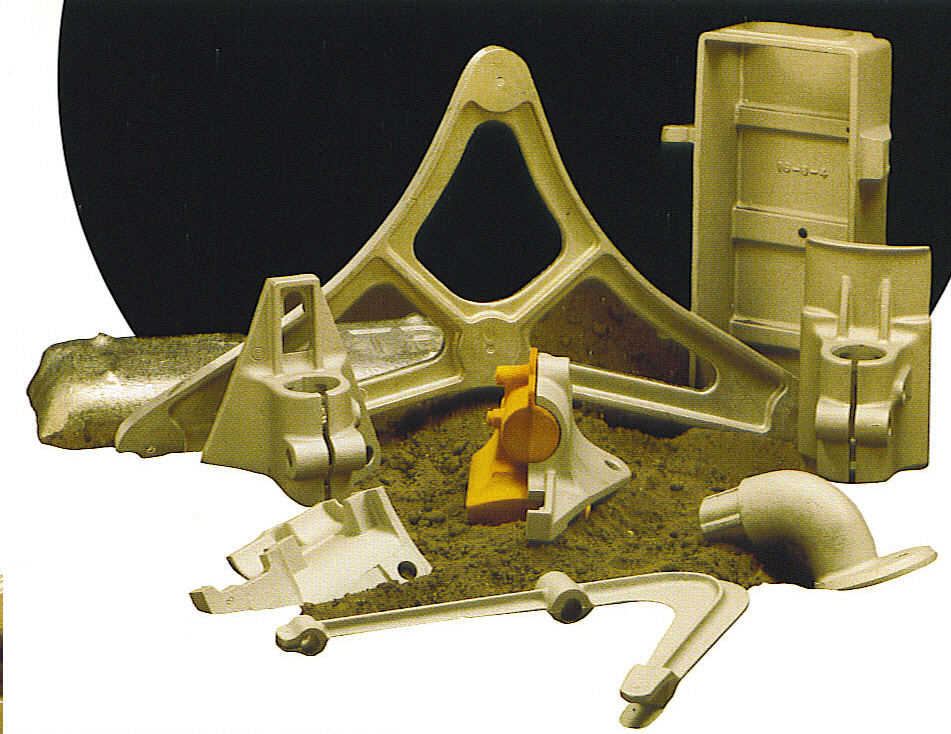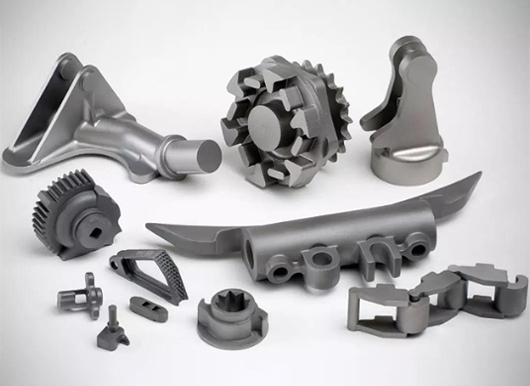Discovering the Advantages and Practical Use Aluminum Castings in Today's Market
Aluminum spreadings have actually ended up being increasingly pertinent in numerous industries as a result of their distinct features. Their lightweight nature and resistance to deterioration make them ideal for demanding applications. In addition, the remarkable strength-to-weight proportion uses considerable benefits in style and manufacturing. As industries proceed to explore their possibility, the complete extent of aluminum spreadings' advantages and applications remains to be completely uncovered. What lies in advance for this functional material?
The Lightweight Benefit of Aluminum Castings
Although lots of products are utilized in production, aluminum castings stand out largely due to their lightweight residential or commercial properties. This characteristic makes light weight aluminum spreadings an eye-catching option for different markets, particularly in aerospace and automobile applications, where weight decrease is important for enhancing gas performance and efficiency. The light-weight nature of light weight aluminum permits manufacturers to create components that are easier to manage and set up, eventually reducing labor costs.
The capacity to generate complicated shapes without significant weight charges makes it possible for developers to innovate while maintaining structural integrity. Aluminum spreadings can properly change much heavier materials, causing considerable savings in shipping and functional expenses. Their lightweight advantage likewise adds to enhanced item durability, as lighter components frequently lead to decreased damage on machinery. Overall, the lightweight residential or commercial properties of aluminum spreadings offer manufacturers with an one-upmanship, cultivating innovations in product layout and effectiveness throughout different markets.

Extraordinary Deterioration Resistance
Light weight aluminum castings possess an all-natural resistance to oxidation, which substantially improves their longevity in numerous settings. This intrinsic residential property not just adds to their sturdiness however also straightens with the lightweight advantage that aluminum supplies. Therefore, aluminum spreadings are increasingly acknowledged for their exceptional rust resistance in countless applications.

Naturally Resistant to Oxidation
One of the standout attributes of aluminum spreadings is their outstanding rust resistance, which comes from a natural oxidation process. When exposed to air, light weight aluminum responds to develop a thin, protective layer of light weight aluminum oxide. This layer works as a barrier against more oxidation and secures the underlying metal from corrosive components such as wetness and salts. Unlike other steels, this oxide layer is self-repairing; if damaged, it promptly reforms when exposed to air. This special residential or commercial property boosts the longevity of aluminum castings in various environments, making them excellent for applications in markets such as aerospace, automobile, and marine. The all-natural resistance to oxidation significantly lowers maintenance prices and enhances the integrity of light weight aluminum castings in requiring conditions.
Lightweight Toughness Advantage
The light-weight nature of aluminum castings adds significantly to their longevity, making them a helpful selection in various markets. This extraordinary longevity is largely attributed to aluminum's natural resistance to corrosion, which is enhanced better with anodizing and various other surface treatments. Unlike numerous steels, aluminum does not corrosion; rather, it develops a protective oxide layer that guards it from ecological damages. This residential property is particularly useful in fields such as auto and aerospace, where weight reduction is essential without compromising strength. Additionally, the durability of aluminum castings reduces upkeep costs and replacements, offering economic advantages over time. Their lightweight resilience and corrosion resistance setting aluminum castings as a premium material for contemporary production applications.

Superior Strength-to-Weight Proportion
An impressive feature of light weight aluminum castings is their superior strength-to-weight proportion, that makes them extremely preferable in various applications. This innate residential or commercial property allows aluminum castings to endure considerable anxiety while continuing to be lightweight, an important variable in sectors such as aerospace, automotive, and manufacturing. Designers typically choose aluminum castings for components that call for both longevity and reduced weight, improving gas performance and performance.
The high strength-to-weight ratio also assists in the design of detailed shapes and frameworks, making aluminum castings functional for facility applications. The capacity to preserve structural honesty under difficult conditions guarantees durability and reliability in products, from aircraft frames to auto components. This advantage adds to the expanding trend of making use of light weight aluminum castings in innovative styles, ultimately bring about enhanced capability and performance across varied industries. The remarkable strength-to-weight proportion of aluminum castings positions them as an essential material in contemporary design and manufacturing.
Cost-Effectiveness in Manufacturing
Cost-effectiveness in aluminum casting production is primarily achieved with minimized product waste and efficient production processes. By optimizing designs and utilizing innovative strategies, makers can minimize excess product use while maintaining high quality standards. This technique not just lowers production expenses yet also adds to extra lasting practices within the sector.
Decreased Product Waste
Minimizing product waste in light weight aluminum spreading procedures greatly enhances manufacturing performance. By maximizing the layout and manufacturing techniques, companies can reduce excess scrap and enhance source application. This decrease in waste not just decreases material prices however also adds to a much more sustainable production model. The capability to reuse light weight aluminum additional supports cost-effectiveness, enabling makers to recover and reuse materials without compromising high quality. As the sector significantly concentrates on sustainability, lowered product waste lines up with environmental objectives while simultaneously boosting profitability. Inevitably, reliable usage of basic materials strengthens the competitive placement of services out there, making aluminum spreadings a positive choice in different applications. The strategic approach to decreasing waste shows a dedication to both economic and ecological obligation.
Efficient Production Processes
While standard manufacturing processes can incur considerable expenses, light weight aluminum spreading offers a much more reliable option that enhances total production productivity. This approach reduces product waste and enables for precise control over the manufacturing procedure, leading to decreased labor and functional costs. The capacity to produce intricate shapes with less steps further enhances manufacturing, contributing to shorter preparations. In addition, aluminum's light-weight nature and excellent thermal conductivity permit power cost savings throughout production and in the final application. By making use of modern spreading innovations, suppliers can accomplish greater throughput without giving up high quality. Aluminum spreading stands out as a cost-efficient service, making it an appealing choice for organizations intending to maximize their manufacturing procedures in today's competitive market.
Flexibility Across Industries
Aluminum spreadings show remarkable flexibility across different markets, as they can be tailored to satisfy particular requirements and applications. In the automobile market, aluminum spreadings are used in engine blocks, transmission housings, and wheels, offering lightweight yet long lasting options that enhance fuel effectiveness. The aerospace sector likewise gains from light weight aluminum castings, using them in architectural parts and engine components as a result of their strength-to-weight proportion.
In the durable goods sector, producers employ aluminum review spreadings for products varying from cookware to furnishings, giving both visual allure and performance. The electronics market uses aluminum castings for real estates and warm sinks, guaranteeing efficient thermal administration. In addition, the construction sector leverages light weight aluminum castings for architectural components and building elements, improving durability and layout adaptability. This broad applicability highlights light weight aluminum spreadings as a vital resource, fulfilling the diverse demands of different markets while keeping high efficiency and reliability.
Sustainability and Ecological Effect
As sectors progressively prioritize sustainable techniques, aluminum spreadings become an environmentally friendly choice due to their recyclability and low ecological footprint. Light weight aluminum is one of one of the most recycled materials globally, with the capability to be repurposed multiple times without degradation of quality. This characteristic considerably reduces the demand for basic materials and power usage connected with main light weight aluminum manufacturing, which is energy-intensive.
Additionally, light weight aluminum castings add to light-weight designs, causing sustain performance in transportation applications such as aerospace and automotive markets. Their durability and resistance to corrosion prolong item lifespans, even more lessening waste and resource usage gradually. Numerous suppliers are learn the facts here now adopting liable sourcing and ecologically pleasant manufacturing approaches, boosting the sustainability of aluminum casting processes. In general, aluminum castings represent a practical service for companies aiming try this website to decrease their environmental impact while achieving efficiency and efficiency.
Technologies in Light Weight Aluminum Spreading Technologies
Recent developments in aluminum spreading innovations have greatly enhanced the performance and high quality of production procedures. Advancements such as 3D printing and advanced mold-making methods have enabled suppliers to produce intricate layouts with decreased material waste. This shift not just enhances the accuracy of cast components however also reduces lead times, permitting fast prototyping and faster market access.
The consolidation of advanced computer system simulations aids in forecasting potential flaws throughout casting, leading to higher-quality outcomes. The use of lightweight alloys has actually also added to the growth of stronger, extra resilient items, providing to industries ranging from automobile to aerospace
Additionally, automated spreading procedures have emerged, lessening human error and boosting production speed. Collectively, these advancements are changing the aluminum spreading landscape, driving better competitiveness and sustainability in manufacturing. As markets proceed to evolve, these innovations will certainly play an important function in conference future needs for performance and top quality.
Frequently Asked Inquiries
How Do Aluminum Castings Compare to Other Metals in Regards To Thermal Conductivity?
Light weight aluminum spreadings display remarkable thermal conductivity contrasted to several steels, such as steel and iron - Aluminum Foundry. Their light-weight nature and efficient heat distribution make them perfect for applications needing efficient thermal management in different markets
What Are the Typical Problems Found in Aluminum Castings?
Common defects in aluminum castings consist of porosity, contraction, additions, and surface irregularities. These issues typically arise from improper cooling prices, insufficient mold design, or contaminations, affecting the overall top quality and performance of the last item.
Can Light Weight Aluminum Castings Be Recycled, and How?
Aluminum castings can be recycled successfully. The process entails collecting, melting, and changing the aluminum, which reduces waste and conserves resources. This recycling contributes to sustainability while keeping the material's residential properties for future usage.
What Are the Common Lead Times for Aluminum Spreading Manufacturing?
Typically, preparations for light weight aluminum spreading production array from 2 to 6 weeks, depending on variables such as complexity, tooling requirements, and production volume. Performance can improve with established vendor relationships and maximized production processes.
Just how Does the Surface End Up Affect Aluminum Spreading Performance?
The surface area finish considerably influences aluminum spreading performance by affecting deterioration resistance, aesthetic top quality, and rubbing qualities. A smoother coating enhances resilience and performance, while a rougher structure can boost adhesion for subsequent coatings or treatments.
Several materials are made use of in manufacturing, light weight aluminum spreadings stand out mainly due to their light-weight residential properties. When exposed to air, light weight aluminum responds to form a thin, safety layer of light weight aluminum oxide. Cost-effectiveness in aluminum casting manufacturing is largely achieved through reduced material waste and efficient production procedures. Minimizing material waste in aluminum spreading processes greatly boosts production efficiency. Ultimately, effective usage of raw products reinforces the affordable placement of companies in the market, making aluminum spreadings a positive alternative in numerous applications.